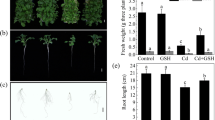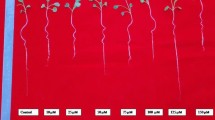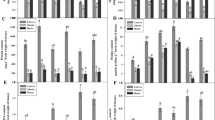Abstract
Water contamination with cadmium (Cd) is a global environmental problem and its remediation becomes urgent. Phytoremediation using ornamental plants has attracted much attention for its advantages of cost-effectiveness and beautification of the environment. Nelumbo nucifera G. is a popular ornamental aquatic macrophyte with fast growth, large biomass, and high capacities for Cd accumulation and removal. However, information about Cd resistance and defense responses in N. nucifera is rather scarce, which restricts its large-scale utilization for phytoremediation. The phytohormone ethylene plays an important role in plant resistance to Cd stress, but the underlying mechanism remains unclear. In this study, we investigated morphophysiological responses of N. nucifera seedlings to Cd stress, and focused on the effects of ethylene on oxidative damage, Cd accumulation, and antioxidant defense system at the metabolic and transcript levels in leaves under Cd stress. Our results showed that Cd exposure led to leaf chlorosis and necrosis, coupled with an increase in contents of hydrogen peroxide, electrolyte leakage, and malondialdehyde, and decrease in chlorophyll content. Exogenous ethylene precursor 1-aminocyclopropane-1-carboxylic acid (ACC) application intensified Cd-induced stress responses and Cd accumulation, and increased ethylene production by inducing ACC synthase (ACS) gene NnACS. Such enhanced ethylene emission inhibited catalase (CAT), ascorbate peroxidase (APX), and glutathione reductase (GR) activities, and modulated ascorbate (AsA) and glutathione (GSH) accumulation through transcriptional regulation of their respective metabolic genes. After ethylene action inhibitor silver thiosulfate (STS) supplementation, Cd-induced oxidative damage was abolished, and Cd content declined but still at a relatively high level. Blocking of ethylene perception by STS inhibited ethylene biosynthesis; enhanced CAT, APX, and GR activities and their transcript levels; increased AsA accumulation via inducing its biosynthetic genes; but reduced GSH content and NnGSH2 expression level. These results suggest that ethylene biosynthesis and signaling play an important role in N. nucifera response to Cd stress, and maintaining appropriate ethylene level and low ethylene sensitivity could improve its Cd tolerance via efficient antioxidant defenses.










Similar content being viewed by others
References
Akram NA, Shafiq F, Ashraf M (2017) Ascorbic acid-a potential oxidant scavenger and its role in plant development and abiotic stress tolerance. Front Plant Sci:8. https://doi.org/10.3389/fpls.2017.00613
Alves LR, Rodrigues Dos Reis A, Prado ER, Lavres J, Pompeu GB, Azevedo RA, Gratao PL (2019) New insights into cadmium stressful-conditions: role of ethylene on selenium-mediated antioxidant enzymes. Ecotoxicol Environ Saf 186:109747. https://doi.org/10.1016/j.ecoenv.2019.109747
Asgher M, Khan NA, Khan MIR, Fatma M, Masood A (2014) Ethylene production is associated with alleviation of cadmium-induced oxidative stress by sulfur in mustard types differing in ethylene sensitivity. Ecotoxicol Environ Saf 106:54–61. https://doi.org/10.1016/j.ecoenv.2014.04.017
Baczek-Kwinta R, Antonkiewicz J, Lopata-Stasiak A, Kepka W (2019a) Smoke compounds aggravate stress inflicted on Brassica seedlings by unfavourable soil conditions. Photosynthetica 57:1–8. https://doi.org/10.32615/ps.2019.026
Baczek-Kwinta R, Juzon K, Borek M, Antonkiewicz J (2019b) Photosynthetic response of cabbage in cadmium-spiked soil. Photosynthetica 57:731–739. https://doi.org/10.32615/ps.2019.070
Baryla A, Carrier P, Franck F, Coulomb C, Sahut C, Havaux M (2001) Leaf chlorosis in oilseed rape plants (Brassica napus) grown on cadmium-polluted soil: causes and consequences for photosynthesis and growth. Planta 212:696–709. https://doi.org/10.1007/s004250000439
Bellincampi D, Dipierro N, Salvi G, Cervone F, De Lorenzo G (2000) Extracellular H(2)O(2) induced by oligogalacturonides is not involved in the inhibition of the auxin-regulated rolB gene expression in tobacco leaf explants. Plant Physiol 122:1379–1385. https://doi.org/10.1104/pp.122.4.1379
Bucker-Neto L, Paiva ALS, Machado RD, Arenhart RA, Margis-Pinheiro M (2017) Interactions between plant hormones and heavy metals responses. Genet Mol Biol 40:373–386. https://doi.org/10.1590/1678-4685-gmb-2016-0087
Cao FB, Chen F, Sun HY, Zhang GP, Chen ZH, Wu FB (2014) Genome-wide transcriptome and functional analysis of two contrasting genotypes reveals key genes for cadmium tolerance in barley. BMC Genomics:15. https://doi.org/10.1186/1471-2164-15-611
Chae HS, Lee WS (2001) Ethylene- and enzyme-mediated superoxide production and cell death in carrot cells grown under carbon starvation. Plant Cell Rep 20:256–261. https://doi.org/10.1007/s002990000307
Chen Q, Wu KX, Tang ZH, Guo QX, Guo XR, Wang HZ (2017) Exogenous ethylene enhanced the cadmium resistance and changed the alkaloid biosynthesis in Catharanthus roseus seedlings. Acta Physiol Plant:39. https://doi.org/10.1007/s11738-017-2567-6
Cuypers A, Plusquin M, Remans T, Jozefczak M, Keunen E, Gielen H, Opdenakker K, Nair AR, Munters E, Artois TJ, Nawrot T, Vangronsveld J, Smeets K (2010) Cadmium stress: an oxidative challenge. Biometals 23:927–940. https://doi.org/10.1007/s10534-010-9329-x
Das S, Goswami S, Talukdar AD (2014) A study on cadmium phytoremediation potential of water lettuce, Pistia stratiotes L. Bull Environ Contam Toxicol 92:169–174. https://doi.org/10.1007/s00128-013-1152-y
Dauda AB, Ajadi A, Tola-Fabunmi AS, Akinwole AO (2019) Waste production in aquaculture: sources, components and managements in different culture systems. Aquacult Fish 4:81–88. https://doi.org/10.1016/j.aaf.2018.10.002
Dhindsa RS, Plumb-dhindsa P, Thorpe TA (1981) Leaf senescence: correlated with increased levels of membrane permeability and lipid peroxidation, and decreased levels of superoxide dismutase and catalase. J Exp Bot 32:93–101. https://doi.org/10.1093/jxb/32.1.93
Foyer CH, Halliwell B (1976) The presence of glutathione and glutathione reductase in chloroplasts: a proposed role in ascorbic acid metabolism. Planta 133:21–25. https://doi.org/10.1007/bf00386001
Gallego SM, Pena LB, Barcia RA, Azpilicueta CE, Iannone MF, Rosales EP, Zawoznik MS, Groppa MD, Benavides MP (2012) Unravelling cadmium toxicity and tolerance in plants: insight into regulatory mechanisms. Environ Exp Bot 83:33–46. https://doi.org/10.1016/j.envexpbot.2012.04.006
Gergoff G, Chaves A, Bartoli CG (2010) Ethylene regulates ascorbic acid content during dark-induced leaf senescence. Plant Sci 178:207–212. https://doi.org/10.1016/j.plantsci.2009.12.003
Gratao PL, Polle A, Lea PJ, Azevedo RA (2005) Making the life of heavy metal-stressed plants a little easier. Funct Plant Biol 32:481–494. https://doi.org/10.1071/fp05016
Gratao PL, Monteiro CC, Carvalho RF, Tezotto T, Piotto FA, Peres LEP, Azevedo RA (2012) Biochemical dissection of diageotropica and Never ripe tomato mutants to Cd-stressful conditions. Plant Physiol Biochem 56:79–96. https://doi.org/10.1016/j.plaphy.2012.04.009
Guan CF, Ji J, Wu DY, Li XZ, Jin C, Guan WZ, Wang G (2015) The glutathione synthesis may be regulated by cadmium-induced endogenous ethylene in Lycium chinense, and overexpression of an ethylene responsive transcription factor gene enhances tolerance to cadmium stress in tobacco. Mol Breed:35. https://doi.org/10.1007/s11032-015-0313-6
Hiraga S, Sasaki K, Ito H, Ohashi Y, Matsui H (2001) A large family of class III plant peroxidases. Plant Cell Physiol 42:462–468. https://doi.org/10.1093/pcp/pce061
Ismael MA, Elyamine AM, Moussa MG, Cai MM, Zhao XH, Hu CX (2019) Cadmium in plants: uptake, toxicity, and its interactions with selenium fertilizers. Metallomics 11:255–277. https://doi.org/10.1039/c8mt00247a
Kaur N, Jhanji S (2016) Effect of soil cadmium on growth, photosynthesis and quality of Raphanus sativus and Lactuca sativa. J Environ Biol 37:993–997
Keunen E, Schellingen K, Vangronsveldand J, Cuypers A (2016) Ethylene and metal stress: small molecule, Big Impact. Front Plant Sci 7. https://doi.org/10.3389/fpls.2016.00023
Khan MIR, Khan NA (2014) Ethylene reverses photosynthetic inhibition by nickel and zinc in mustard through changes in PS II activity, photosynthetic nitrogen use efficiency, and antioxidant metabolism. Protoplasma 251:1007–1019. https://doi.org/10.1007/s00709-014-0610-7
Khan MIR, Jahan B, Alajmi MF, Rehman MT, Khan NA (2019) Exogenously-sourced ethylene modulates defense mechanisms and promotes tolerance to zinc stress in mustard (Brassica juncea L.). Plants:8. https://doi.org/10.3390/plants8120540
Kim DY, Bovet L, Kushnir S, Noh EW, Martinoia E, Lee Y (2006) AtATM3 is involved in heavy metal resistance in Arabidopsis. Plant Physiol 140:922–932. https://doi.org/10.1104/pp.105.074146
Kim DY, Bovet L, Maeshima M, Martinoia E, Lee Y (2007) The ABC transporter AtPDR8 is a cadmium extrusion pump conferring heavy metal resistance. Plant J 50:207–218. https://doi.org/10.1111/j.1365-313X.2007.03044.x
Kong D, Pei K, Li Y, Zhang M (2010) Effect of Cd, Zn and Pb stresses on physiology and biochemistry of lotus. J Henan Agric Univ 44(4):401–407 (in Chinese)
Kovtun Y, Chiu WL, Tena G, Sheen J (2000) Functional analysis of oxidative stress-activated mitogen-activated protein kinase cascade in plants. Proc Natl Acad Sci U S A 97:2940–2945. https://doi.org/10.1073/pnas.97.6.2940
Lajayer BA, Moghadam NK, Maghsoodi MR, Ghorbanpour M, Kariman K (2019) Phytoextraction of heavy metals from contaminated soil, water and atmosphere using ornamental plants: mechanisms and efficiency improvement strategies. Environ Sci Pollut Res 26:8468–8484. https://doi.org/10.1007/s11356-019-04241-y
Li GJ, Meng XZ, Wang RG, Mao GH, Han L, Liu YD, Zhang SQ (2012) Dual-level regulation of ACC synthase activity by MPK3/MPK6 cascade and its downstream WRKY transcription factor during ethylene induction in Arabidopsis. PLoS Genet 8:e1002767. https://doi.org/10.1371/journal.pgen.1002767
Lin ZF, Zhong SL, Grierson D (2009) Recent advances in ethylene research. J Exp Bot 60:3311–3336. https://doi.org/10.1093/jxb/erp204
Liu YD, Zhang SQ (2004) Phosphorylation of 1-aminocyclopropane-1-carboxylic acid synthase by MPK6, a stress-responsive mitogen-activated protein kinase, induces ethylene biosynthesis in Arabidopsis. Plant Cell 16:3386–3399. https://doi.org/10.1105/tpc.104.026609
Liu XJ, Shiomi S, Nakatsuka A, Kubo Y, Nakamura R, Inaba A (1999) Characterization of ethylene biosynthesis associated with ripening in banana fruit. Plant Physiol 121:1257–1265. https://doi.org/10.1104/pp.121.4.1257
Liu XM, Kim KE, Kim KC, Nguyen XC, Han HJ, Jung MS, Kim HS, Kim SH, Park HC, Yun DJ, Chung WS (2010) Cadmium activates Arabidopsis MPK3 and MPK6 via accumulation of reactive oxygen species. Phytochemistry 71:614–618. https://doi.org/10.1016/j.phytochem.2010.01.005
Liu AM, Tian DK, Xiang YC, Mo HB (2016) Effects of biochar on growth of Asian lotus (Nelumbo nucifera Gaertn.) and cadmium uptake in artificially cadmium-polluted water. Sci Hortic 198:311–317. https://doi.org/10.1016/j.scienta.2015.11.030
Livak KJ, Schmittgen TD (2001) Analysis of relative gene expression data using real-time quantitative PCR and the 2(T)(-Delta Delta C) method. Methods 25:402–408. https://doi.org/10.1006/meth.2001.1262
Lu WP, Kirkham MB (1991) Genotypic tolerance to metals as indicated by ethylene production. Water Air Soil Pollut 57-58:605–615. https://doi.org/10.1007/bf00282924
Lu XY, Chen Q, Cui XY, Zu YG, Tang ZH (2019) Contribution of ethylene to the cadmium resistance of Thale cress (Arabidopsis thaliana). Appl Ecol Environ Res 17:14403–14414. https://doi.org/10.15666/aeer/1706_1440314414
Masood A, Iqbal N, Khan NA (2012) Role of ethylene in alleviation of cadmium-induced photosynthetic capacity inhibition by sulphur in mustard. Plant Cell Environ 35:524–533. https://doi.org/10.1111/j.1365-3040.2011.02432.x
Mishra V, Pathak V, Tripathi B (2009) Accumulation of cadmium and copper from aqueous solutions using Indian lotus (Nelumbo nucifera). Ambio 38:110–112
Montero-Palmero MB, Martin-Barranco A, Escobar C, Hernandez LE (2014) Early transcriptional responses to mercury: a role for ethylene in mercury-induced stress. New Phytol 201:116–130. https://doi.org/10.1111/nph.12486
Nakano Y, Asada K (1981) Hydrogen peroxide is scavenged by ascorbate-specific peroxidase in spinach chloroplasts. Plant Cell Physiol 22:867–880. https://doi.org/10.1093/oxfordjournals.pcp.a076232
Romero-Puertas MC, Palma JM, Gomez M, Del Rio LA, Sandalio LM (2002) Cadmium causes the oxidative modification of proteins in pea plants. Plant Cell Environ 25:677–686. https://doi.org/10.1046/j.1365-3040.2002.00850.x
Schellingen K, Van Der Straeten D, Vandenbussche F, Prinsen E, Remans T, Vangronsveld J, Cuypers A (2014) Cadmium-induced ethylene production and responses in Arabidopsis thaliana rely on ACS2 and ACS6 gene expression. BMC Plant Biol 14. https://doi.org/10.1186/s12870-014-0214-6
Schellingen K, Van Der Straeten D, Remans T, Loix C, Vangronsveld J, Cuypers A (2015a) Ethylene biosynthesis is involved in the early oxidative challenge induced by moderate Cd exposure in Arabidopsis thaliana. Environ Exp Bot 117:1–11. https://doi.org/10.1016/j.envexpbot.2015.04.005
Schellingen K, Van Der Straeten D, Remans T, Vangronsveld J, Keunen E, Cuypers A (2015b) Ethylene signalling is mediating the early cadmium-induced oxidative challenge in Arabidopsis thaliana. Plant Sci 239:137–146. https://doi.org/10.1016/j.plantsci.2015.07.015
Steffens J (1990) The heavy metal-binding peptides of plants. Annu Rev Plant Physiol Plant Mol Biol 41:553–575. https://doi.org/10.1146/annurev.pp.41.060190.003005
Sytar O, Kumari P, Yadav S, Brestic M, Rastogi A (2019) Phytohormone priming: regulator for heavy metal stress in plants. J Plant Growth Regul 38:739–752. https://doi.org/10.1007/s00344-018-9886-8
Thao NP, Khan MIR, Thu NBA, Hoang XLT, Asgher M, Khan NA, Tran LSP (2015) Role of ethylene and its cross talk with other signaling molecules in plant responses to heavy metal stress. Plant Physiol 169:73–84. https://doi.org/10.1104/pp.15.00663
Vajpayee P, Sharma SC, Tripathi RD, Rai UN, Yunus M (1999) Bioaccumulation of chromium and toxicity to photosynthetic pigments, nitrate reductase activity and protein content of Nelumbo nucifera Gaertn. Chemosphere 39:2159–2169. https://doi.org/10.1016/s0045-6535(99)00095-8
Vaseva I et al (2012) Antioxidant response to drought in red and white clover. Acta Physiol Plant 34:1689–1699. https://doi.org/10.1007/s11738-012-0964-4
Wang Y, Zhang C, Jia P, Wang X, Wang W, Dong L (2013) Isolation and expression analysis of three EIN3-like genes in tree peony (Paeonia suffruticosa). Plant Cell Tissue Organ Cult 112:1–10. https://doi.org/10.1007/s11240-012-0220-z
Wang Y, Zhang C, Wang X, Wang W, Dong L (2014) Involvement of glucose in the regulation of ethylene biosynthesis and sensitivity in cut Paeonia suffruticosa flowers. Sci Hortic 169:44–50. https://doi.org/10.1016/j.scienta.2014.02.017
Wang YJ, Chen YQ, Yuan M, Xue ZY, Jin QJ, Xu YC (2016) Flower color diversity revealed by differential expression of flavonoid biosynthetic genes in sacred Lotus. J Am Soc Hortic Sci 141:573. https://doi.org/10.21273/jashs03848-16
Wang Y, Chen Y, Xue Z, Zhou H, Jing Q, Xu Y (2017) Selection and validation of reference genes for RT-qPCR normalization in lotus (Nelumbo nucifera) during petal coloration. J Nanjing Agric Univ 40(3):408–415 (in Chinese)
Wu ZC, Liu S, Zhao J, Wang F, du Y, Zou S, Li H, Wen D, Huang Y (2017) Comparative responses to silicon and selenium in relation to antioxidant enzyme system and the glutathione-ascorbate cycle in flowering Chinese cabbage (Brassica campestris L. ssp chinensis var. utilis) under cadmium stress. Environ Exp Bot 133:1–11. https://doi.org/10.1016/j.envexpbot.2016.09.005
Yu YW, Wang J, Li S, Kakan X, Zhou Y, Miao Y, Wang F, Qin H, Huang R (2019) Ascorbic acid integrates the antagonistic modulation of ethylene and abscisic acid in the accumulation of reactive oxygen species. Plant Physiol 179:1861–1875. https://doi.org/10.1104/pp.18.01250
Zhang JX, Kirkham MB (1996) Antioxidant responses to drought in sunflower and sorghum seedlings. New Phytol 132:361–373. https://doi.org/10.1111/j.1469-8137.1996.tb01856.x
Zhang SY, Yu YW, Xiao CL, Wang XD, Tian YY (2013) Effect of carbon monoxide on browning of fresh-cut lotus root slice in relation to phenolic metabolism. Lwt-Food Sci Technol 53:555–559. https://doi.org/10.1016/j.lwt.2013.04.001
Zhang B, Shang S, Jabeen Z, Zhang GP (2014a) Involvement of ethylene in alleviation of Cd toxicity by NaCl in tobacco plants. Ecotoxicol Environ Saf 101:64–69. https://doi.org/10.1016/j.ecoenv.2013.12.013
Zhang YY, He QQ, Zhao SY, Huang LL, Hao L (2014b) Arabidopsis ein2-1 and npr1-1 response to Al stress. Bull Environ Contam Toxicol 93:78–83. https://doi.org/10.1007/s00128-014-1249-y
Funding
This work was supported by the National Natural Science Foundation of China (no. 31400600; 31772346; 31971710), the Natural Science Foundation of Jiangsu Province (no. BK20140695), and the China Postdoctoral Science Foundation (no. 2014M561674).
Author information
Authors and Affiliations
Corresponding author
Additional information
Responsible editor: Gangrong Shi
Publisher’s note
Springer Nature remains neutral with regard to jurisdictional claims in published maps and institutional affiliations.
Rights and permissions
About this article
Cite this article
Wang, Y., Yuan, M., Li, Z. et al. Effects of ethylene biosynthesis and signaling on oxidative stress and antioxidant defense system in Nelumbo nucifera G. under cadmium exposure. Environ Sci Pollut Res 27, 40156–40170 (2020). https://doi.org/10.1007/s11356-020-09918-3
Received:
Accepted:
Published:
Issue Date:
DOI: https://doi.org/10.1007/s11356-020-09918-3




